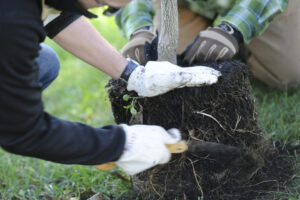Leaflet: It’s Time To Put Down Some Roots

Last month, we told you why you should leave the leaves. We got such great feedback that we decided to create a regular tree care column, Leaflet, so that our eager experts can pass on their knowledge. We’ll share best practices for tree care and maintenance, explore common myths and misconceptions, and dig into the science behind it all.
“Now that the leaves are on the ground, we get busy,” says Neighborhood Trees Senior Specialist Drew Land about the November tree planting season. “Speaking of busy, roots are always busy.” We plant trees now so that while the trees are dormant above ground, they can focus on establishing their roots below ground. From timing to mulching to watering, our strategies help shape the tree’s root system.
“Street trees are not truly part of the urban forest until their roots start to intermingle,” Drew says. That’s why making sure a tree’s roots get established properly is a crucial part of planting and maintenance.
Because roots are almost entirely underground, we don’t really think about the shape of their structure. Rather than just a main tap root that goes straight down, 85% of a tree’s roots are within the top 24 inches of soil, or at least they should be. In the urban environment, roots are often up against the challenge of compacted and nutrient-depleted soil. In situations like these, roots will be too shallow, because they don’t have the space to seek out water and oxygen. Trees in the forest enjoy uncompacted soil with plenty of air and water spaces below ground. This also gives room for the fungal and microbial activity that brings soil to life.
“Roots are opportunists,” Drew says. “They follow the resources.” Given the right moisture and temperature, tree roots can grow year round. Insulation from mulch maintains those conditions, and we spread it in a way that encourages the roots to grow outward. Similarly, we shouldn’t just water at the base of a tree’s trunk, but should aim to water the tips of roots as they grow outward from the trunk. And we should water long enough that it sinks beyond the surface. Deep, infrequent watering mimics natural rain storms and gives roots what they need to spread both outward and downward. “Well-meaning people often shallow water on a daily basis, but that only feeds grass/weeds and not the tree roots a foot below. “
Tree roots come in two main types: structural roots and feeder roots. Structural roots are woody, and serve as the architecture to keep the tree upright. Feeder roots, which are much more like root hairs, are in charge of absorbing water and nutrients.

Maybe you have heard the myth that tree roots can grow into your sewer or water pipes and bust them open. Drew is here to officially bust that myth. He says that while roots are opportunistic, they are not invasive. “So the roots are not busting your sewer line,” he promises. “Your line is already busted and the roots found a tasty water source.”
Recreating ideal natural conditions is the best way to ensure that the roots of our urban trees stay healthy. “Roots are like muscles,” Drew says. “They grow in response to stress.” When you tie a newly planted tree too tightly to a support, it won’t have the freedom to move in the wind, building up those root “muscles” to support itself.
Getting the roots established is one of the most important reasons we plant new trees in the fall. “Planting trees now, while they’re dormant, will build their resilience,” Drew says. ”In ten months, when autumn winds hit their leaves for the first time, they’ll be ready.”
Further reading:
- “Roots Demystified” by Robert Kourik
- “Up by Roots” by Jim Urban
